Introduction
All healthcare professionals, including physical therapists (PTs), encounter human suffering in their everyday practice as healers. Human suffering can raise fundamental questions related to health, wellness, illness, disability, life or death, and grieving. These questions challenge practitioners who have been educated on behavioral objectives based on traditional cognitive, psychomotor, and affective domains of learning1 to provide adequate and compassionate care for their patients and families. To make situations more challenging, PTs may encounter ethical dilemmas when dealing with patient-practitioner interactions within the healthcare system.2 Physical therapists need to respond properly to situations involving ethical issues as well as manage the distress characterized by human suffering. Traditional classroom environments where the skills and science of physical therapy are taught often fall short in pedagogy to engage students in the three domains of learning (cognitive, affective, psychomotor) within the clinical context.3 Students may cognitively understand how to physically respond to difficult situations but the deeper connection to the heart of distress, and how to respond, often cannot be taught through traditional pedagogical processes.
Medical humanities (MH) and health humanities (HH) are tools to help students develop the ability to communicate about difficult topics while also nurturing skills of observation, creativity, imagination, intuition, empathy and self-reflection, all crucial to holistic practice in healthcare.4-17 Defined by Hurwitz in 2003, MH involve the use of literature and the arts as a means of exploring and discussing human issues pertinent to the health professional.18 The term HH has been coined to represent a broader, more inclusive population of health professionals rather than just those studying medicine.19 This study examines the influence of an art show on professional beliefs of students and on the local community’s understanding of the physical therapy profession. Two hypotheses guided the questions for this investigation: 1) Doctor of Physical Therapy (DPT) students involved in the HH through visual arts will demonstrate a greater understanding of how physical therapy may transform society; and 2) community members will obtain a greater understanding of how physical therapy improves the human condition through the experience of an art show.
The American Physical Therapy Association (APTA) developed a new vision statement in 2013, stating physical therapists are active in “transforming society by optimizing movement to improve the human experience.”20, 21 Principals involved in this new vision statement were meant to inspire the profession and members of society. Eight guiding principles inform the APTA vision statement: identity, quality, collaboration, value, innovation, consumer-centricity, access/equity, and advocacy. Vision statements regarding a deeper connection to society are lofty, but they often beg the question: How does a profession bring that vision to reality and connect with society?
Background
The study and exploration of art in general and the liberal arts more specifically provide a deeper connection to the human experience or condition.4-19 Liberal arts preparation has been viewed as both a necessary prerequisite and an unessential hurdle or relic in the preparation of healthcare professionals. Nevertheless, liberal arts are often a part of prerequisites into entry-level healthcare professional programs and are often neglected once the professional studies commence.4,6-8,11,13,15,17,18 Exposure to the liberal arts as a prerequisite is not enough. Pierce13 suggested liberal arts are a necessary component in the journey to competence as a healthcare provider because they enhance reflective practice skills by providing a structure for reflection. Pierce believed the study of the liberal arts helps students and professionals meet expanded roles as professional and societal citizens through a deeper connection to the human experience. Chomsky22 argued that individuals learn more about the human condition from the arts than from scientific literature alone. Perakis12 suggested while the arts in general may be both disturbing and eye-opening, visual images are powerful and catalyze change. As students examine their role in society from a professional perspective, engaging in HH through the visual arts provides an avenue to address reactions to human suffering. The visual arts provide an initiation to a deeper understanding of the human condition through focused self-reflection and personal transformation.6, 7, 11-15, 17,19
While discourse regarding holistic training of physicians and other healthcare professionals has embraced the pedagogy of HH, curricular inclusion of humanities in health professions has been both encouraged and debated.3-19 Proponents of HH claim inclusion of the arts in medical education, for instance, provides medical students with a greater ability to extract meaning from lived experiences17 and an ability to connect with shared human experiences.6-9, 11,12, 14, 15-19 Respect for individual differences, an enriched use of language, and expanded appreciation of others’ perspectives and lived experiences also occur as a result of exposure to HH and the visual arts.16 Smith et al15 suggest that including HH in the training of health professionals results in a deeper appreciation of the complexity of human experiences, a greater sensitivity to individual differences, and a more nuanced understanding of illness, suffering, dying, and grieving. Smith et al15 further suggest that students involved in HH gain a greater ability to make deeper connections between personal and professional knowledge when dealing with situations infused with grief. Perakis12 suggests that students exposed to HH are better equipped to deal with suffering and afflictions of those they serve. Students also possess more sophisticated expressive and observational skills as a result of HH and art-based learning.8,12,14,15 Creating and experiencing visual art provides holistic techniques for deep self-reflection and allows access to sharing lived human experience in ways not possible through traditional discussion groups, patient simulations, written papers, or presentations.14
Insights from HH allow students and the community to view lived experiences from the eyes of the other and gain new ways of seeing possibilities for reaching full participation in life roles.6 Middleton and Drucquer11 discuss using an artist’s view as a means to approach patients through multiple lenses to adapt to challenging situations. The artist’s view may allow the healthcare practitioner to demonstrate improved human interaction and better pattern recognition skill when diagnosing patients. In addition, the visual arts can aid in self-care of the practitioner. After a long day of stress, patient-practitioner interactions and strategies of engaging with visual arts may lead to improved coping skills.11 Kirklin et al8 suggest that visual arts-based observational skills correlate to improved observational skills of doctors and nurses in determining when to refer patients with skin lesions to dermatology, thus ultimately improving patient-practitioner relations and overall care. Macnaughton10 suggests that the healthcare practitioner as artist seizes an opportunity for greater creativity in providing care, improving the human condition of both the patient and the practitioner.
The marriage of science and art is not new. In his history of medicine, Porter23 points out that the ancient Greeks emphasized the common ground between philosophy, medicine, and ethics. With the increased emphasis on evidence-based practice in physical therapy and medicine, the humanities and arts have been relegated to a lesser position. Yet, the essence of the patient and practitioner experiences may not be measured solely through numbers using positivistic approaches to research.24-28 The artist’s view of the world emphasizes common ground in society by providing insights into fundamental issues regarding human existence, including death and dying.11 The visual arts provide the community with a stage to learn about a profession and possibilities for improved function and transformation.
While there is much literature on the use of HH in the preparation of physicians, nurses, occupational therapists, and others such as emergency medical technicians, a paucity exists regarding the role the visual arts might play in physical therapist education. There was also no evidence in the literature about how the visual arts influenced the education of the community on the roles of physical therapists. This study attempts to fill those gaps in the literature.
Methods
To address the purpose and hypotheses of this study, community-based participatory research (CBPR) methods incorporate a phenomenological survey to examine lived experiences of DPT students staging an art show and community members attending the show. CBPR involves “a commitment to conducting research that shares power and engages community partners in the research process and benefits the communities involved, either through direct intervention or by translating research findings into interventions and policy change.”29 (p.4-5) More than a collaborative approach, CBPR involves building trust and sharing power through all phases of conceptualizing the research problem, conducting research, and disseminating findings.29 All parties learn from the process. Results from a CBPR project may not necessarily be disseminated as a peer-reviewed research paper, but may also take on some other form of education within the community.
For this research project, the DPT program was approached by the university to consider ways in which the university and greater community might learn about the physical therapy program at the university. A professor in the DPT program had preliminary discussions with an art professor who was planning to host an art show in the fall. A partnership was formed between the DPT program, the university, and the greater civic community resulting in an opportunity for the DPT program to share the message of physical therapy identity with the community through the shared time and space of an art show. An opportunity for the DPT program to display visual art describing the intersection of the International Classification of Function (ICF) model and the new APTA vision statement was established.
Phenomenological methods were used to explore the lived experiences of physical therapist students who staged the art show as part of a capstone experience in a DPT curriculum and the experiences of community members who attended the art show. Phenomenological research is qualitative in nature and examines lived experiences to derive meaning from those experiences.24-28 In this process, researchers attempt to set aside personal experiences and biases to understand trends that develop from the lived reality of research participants. Author van Manen defined phenomenology as “the study of the lifeworld or our everyday experiences and the meanings we construct from our experiences.”24(p. 33) Two main assumptions in phenomenological research are: 1) humans seek meaning in their lives; and 2) multiple realities exist that are socially constructed.24-28
Procedures
The study was approved by the IRB with exempt status at Davenport University in Grand Rapids, MI. Inclusion criteria included being a DPT student enrolled in a Critical Integration course in the last year of the DPT curriculum in a Midwestern university. For community members, inclusion criteria included being in attendance at the art show. Adding comments to the reflective journals implied consent of the community members and no names were recorded.
Participants
A sample of convenience was used in this study. After staging the art show, DPT students (n=40) were invited to write confidential reflective papers about the experience of creating art as part of the curriculum in the DPT program. Community members (n=30) from the local university and civic community were invited to attend the art show through a newspaper announcement and university communications. These community members had the opportunity to reflect on thoughts, feelings, and lessons learned about physical therapy as a result of attending the art show. Table 1 lists the type of visual art on display by medium and title. Reflective writing prompts for students and community members are listed in Table 2.
Table 1: Types of Visual Art & Titles
Photography (12)
Community Wellness
Who are Physical Therapists?
Triathlon: Community Integration
Thinking Within the Lines of Therapy
Waiting for Some PT Fun
Playing with Two Left Legs
Value of PT
Healing Hands
Wrecked
Pride and Passion
A Leg to Stand On
Dignity and Mobility Regained |
Pen/Chalk Drawings (14)
PT Progression
It’s not Therapy if it’s not Physical
Recovery to Your Potential
Journey from Pain to Wellness
Layers of Motion
The Art of Helping Others
Physical Therapy Across the Lifespan
Bones
Helping Each Other Up
A Walk to Remember
It Starts from the Ground Up
Capturing Movement
Physical Therapy Gets Results
Equine Therapy: Riding through Life as a Quadriplegic |
Paintings (4)
Physical Therapy
Heavenly Hands
The Viscosity of Life
Breath and Movement |
Sculptures (6)
Tools of Change
PT: A JOINT Effort
“Progression Highway”
Rock Hard
Proporzionale
Improving Quality of Life |
Collage/Mixed Media (1)
Hands |
Video (1)
Art in Motion |
3D Interactive Media (2)
Flipping through Rehab (Flipbook)
The Allure of Human Movement, a Haiku (Calligraphy) |
Table 2: Reflective Writing Prompts for DPT Students and Community Members
| DPT Student Reflective Writing Prompts |
| What were your thoughts when you first heard you had to create a piece of art to represent the intersection of the ICF model and the new vision for PT (Transforming society through optimizing movement to improve the human experience)? |
| What were your thoughts when bringing in your art to display? |
| How did you feel as we were staging (setting up) the show? |
| How did you feel on the day of the art show? |
| What was it like to have people view your work of art? |
| What did you learn about yourself through this process? |
| What did you learn about your classmates? |
| What do you believe the community learned about PT? |
| Community Member Reflective Writing Prompts |
| What did you learn from the art show experience? |
| How did the art show make you feel? |
Table 3: Themes and DPT Student Comments on the Art Show
| Challenging Assignment – Skepticism Followed by New Ways of Knowing |
| At first I was a little surprised that we would have to do an art project. The thing that really worried me was there wasn’t any specifications that were required. I have done art shows before but they were for an art class and the teacher usually had some kind of specifications for the show. So, I was a little worried about what I should do. I usually make drawings of realistic things so coming up with a concept on my own was going to be a challenge. *P4 |
| My first thoughts of creating a piece of art were, “why are we making art in PT school?” When I was younger, art was one of my favorite classes, but I lost touch with the importance of the class as I progressed into middle school and art school. Then when in undergraduate studies, I took an art appreciation course that put me to sleep. At this stage of my development, I never thought I would complete another art course, thus, explains the reasons why I had mild levels of anxiety about this class project. After being in slight denial of this art project, I began to churn some ideas in my brain about what I could create as piece of art that was meaningful. *P15 |
| I enjoyed the art project and I am appreciative of the opportunity. I think it was hard to initially get motivated for it because, as third years, we are very singularly motivated by the thought of taking and passing the boards. Ultimately this was a nice break in the curriculum that allowed some fun to be had. *P36 |
| Art: A New Way to Communicate |
| I learned that this was a very challenging task for me. I thought it would be easy, but it was not. It was hard to engage my brain to be creative. I have been focused on the other side of my brain for three years and hadn’t had to use my creative skills. While it was challenging to me to create this painting I found it very rewarding and learned that I need to use my creative side more than I do. *P12 |
| I think the community realized that we are creative minds and not just “scientists.” I think health professionals are usually seen as rigid and not creative, but I think they saw that we can think outside the box. I think this was a great opportunity to see a different side of PT and ourselves and very thankful we had the privilege of doing this project. *P25 |
| It was exciting to have people look at our art work, especially those who don’t know what physical therapy is. It seems like they got a great representation of what we cherish and enjoy about our profession as well as the struggles we face. *P32 |
| Lessons Learned: Openness & Respect for Others, Social Responsibility |
| It was a mixture of nervousness and pride [to have people look at my work]. On one hand I didn’t know if my idea would be communicated thoroughly, but then I realized that it was okay if someone didn’t see my exact thought process. Their interpretation could have been different and just as good, if not better! *P9 |
| I think the community learned that PT is so much more than exercise. I think one of the eye opening things about the art show was that the underlying theme for the majority of the work was community. So many pictures detailed a multitude of people working together. *P3 |
| What I learned about myself through this process that it is important to be open to all types of learning. Although this is something that I [have] rarely done, it allowed for me to access another part of my brain that is rarely used in PT school and that I haven’t used for some time but it was something that I used to do very frequently. I think that I will start implementing the use of more artistic ways to study because I believe that it is very beneficial. *P20 |
| Calling to Physical Therapy Confirmed as Vocation |
| I learned that I have chosen the right profession for me. Through the creation of my artwork l was able to reflect on what physical therapy means to me and how I am able to use the skills that I have learned to educate others in the community and to help improve each patient’s quality of life. l was able to reflect and understand the great gift that physical therapy is able to offer to those in the profession and those in the community. *P3 |
| I learned how creative and talented everyone is in our class. There were some amazing drawings, painting, sculpture, colleagues, and 3-D art. It was incredible to see how much work everyone put into the project. It was neat to see how everyone sees physical therapy differently and how each of our experiences truly shape what we believe in. We are all called to this profession and how we answer our call to practice can be expressed in art. *P31 |
| I learned that I should engage in more creative activities because I do have some talent and good ideas. I learned I should just trust an experience to take me where I need to be and just because I don’t understand the purpose at the beginning doesn’t mean I won’t at the end. I also learned that I have a very strong view of physical therapy and what it means to me. *P37 |
*P# = Participant number
Third-year students in the program were asked to create a piece of art for an art show being staged to celebrate Physical Therapy Month in October as part of a Critical Integration DPT course in the last year of the curriculum in a Midwestern university. The theme of the art project explored the intersection of the World Health Organization (WHO) ICF Model30 and the new vision statement for the American Physical Therapy Association (APTA) which states physical therapy has a role in “Transforming society by optimizing movement to improve the human experience.”20,21 The ICF model moves beyond a medical diagnosis and utilizes a more holistic approach to examine a person’s participation in societal roles despite potential medical diagnosis, functional and activity limitations, as well as environmental and personal contexts which either promote or limit participation in life roles. Students created paintings, sculptures, poems, photographs, flipbooks, collages, or other works of art to express intersection between the ICF Model and the APTA Vision Statement.
Several reflective journals were made available for community member guests to record their thoughts while attending the art show. These handwritten reflections were transcribed for analysis. No names were attached to journal reflections of the community members. The reflective papers from students and transcribed comments from the community were analyzed for themes and a common description of the experience was created. Forty responses were provided from the student artist group and 30 were obtained from community participants. See Figure 1 for the research process used in this study.
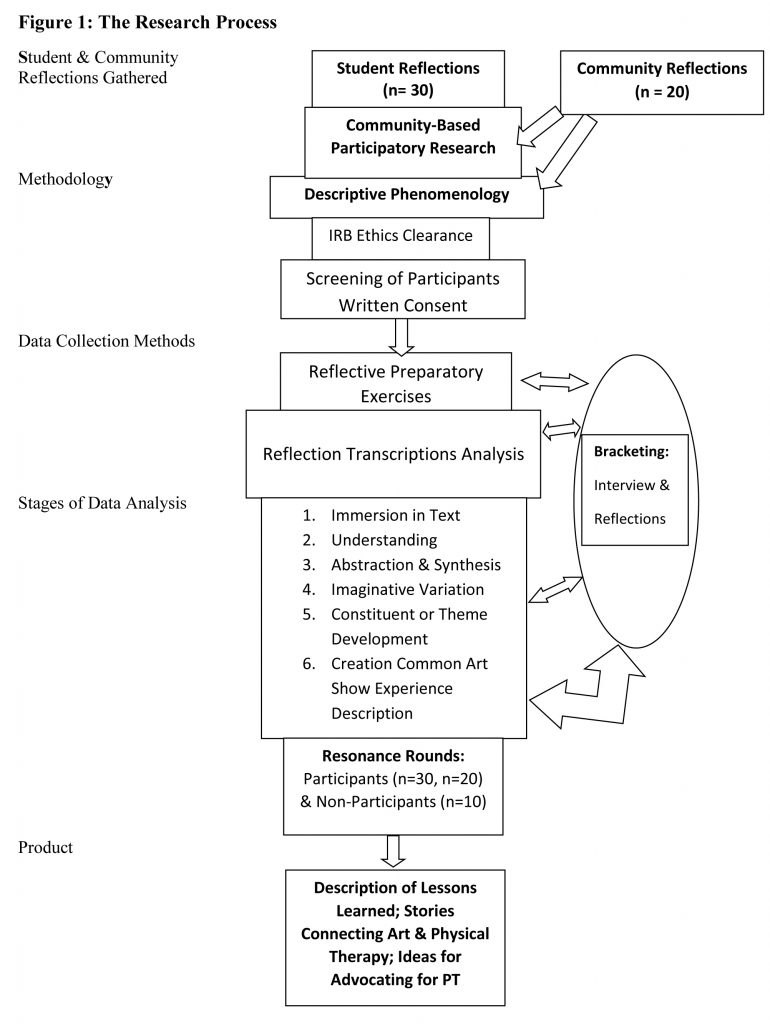
Figure 1: The Research Process
Data Analysis
The reflective papers from the student artists and the written community reflections were analyzed using a descriptive phenomenological approach described by Giorgi27,28 and Dahlberg, Drew, and Nyström.26 This process involved a whole-parts-whole-type holistic examination of the interview texts until constituents or themes of the experience were revealed. Each reflection by the student artists was read two times with the intent to become familiar with the overall tone, word choices, and phrasing. The third reading attended to the flow and structure of the text created by the student artists and main segments of the community participants’ writings were outlined. On the fourth and final reading, key descriptive words or phrases were identified. Important phrases and lists of common elements were used to create a summary of the experience for each participant. Identities of the reflective paper authors were confidential to the primary investigator but anonymous to the other researchers on the team.
The research team collaborated to summarize the essence of the experience with the themes generated by this process. The researchers created a narrative summary and a thematic summary for each participant. These themes were emailed to the student artists who were asked if the interpretation matched the way they lived the art show experience and if the researchers misunderstood or misrepresented anything in the interpretation. Without the participants’ ultimate approval, any descriptions or interpretations of the research team would be inadequate and possibly biased. This process served as a vertical analysis for each reflection received from the student artists. A similar process for completed for the community member reflections. Since the authors of the community writings were anonymous, the common narrative summary and themes were shared with community members who attended the art show after the opening night, but who did not provide reflective writings.
Finally, a horizontal analysis across all written reflections was completed to develop the common description of the experience of staging an art show by the DPT students. Once this process was completed, a summary of the common description and themes across all reflective writings by student artists were shared with the students for review to determine whether or not the common description resonated with the experiences of the student participants. This process also helped ensure dependability and credibility across all student reflections through the member checking process of the common themes. A similar process was used to analyze reflective descriptions of the community members attending the art show. This common description summary was shared with community members who were not a part of this study and did not attend the art show. Saturation was reached by community members after receiving comments from 10 individuals. This process was done to solidify credibility and trustworthiness of the description for the community experience.
Methodological Rigor
Methodological rigor is as important in phenomenology as in other forms of qualitative or quantitative research. Thomas et al24 suggest that the aim of phenomenological research is to find meaning and understanding as opposed to causality and prediction; the criteria to evaluate the rigor of phenomenology is slightly different than what is used in a positivistic process of research. In this case, phenomenological research answers the research questions and the description of the lived experience provides fidelity to the knowledge claim about a lived experience.31 A relationship is thus established between researchers and the community to which the knowledge claim is presented. Furthermore, McClelland states the job of the researcher is to “seek an authentic telling of the experiences and what they mean from the perspective of the participant.”32(p. 178) In this study, methodological rigor was established by allowing participants to engage in the data analysis process by providing clarifying comments about their own descriptions and the common description formed by the analysis across all participants. Hence, CBPR and phenomenology were used to provide a rich description of the elements of everyday life or lived experiences of those being studied to describe how the visual art experience helped student artists and community members better understand the role of physical therapy in society.
Results
Themes and comments from the student artists are listed in Table 3. Students reported being skeptical about the art show initially, but eventually obtaining a deeper understanding of how they may transform society and improve patient care through this assignment. Although the experience was challenging for most students, it helped them confirm that they had chosen the right profession. All students reported being challenged in new ways and they were proud of their use of art to communicate and promote the physical therapy profession. Finally, all students had a plan for displaying their art after the show and ideas regarding an expanded role of advocacy and community engagement.
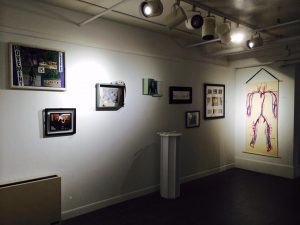 Figure 2: Partial View #1 of the Art Show |
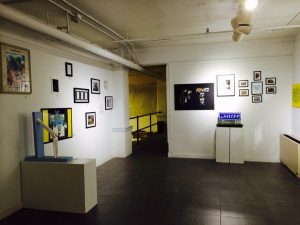 Figure 3: Art Show View #2 |
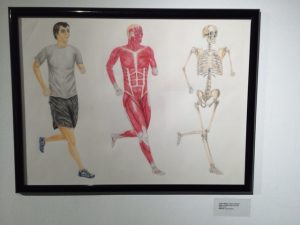 Figure 4: Example of an Art Project |
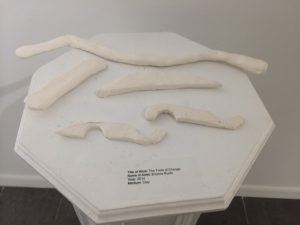 Figure 5: Art Show Project |
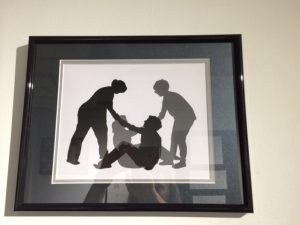 Figure 6: Art Show Project |
Figures 2 – 6 show examples of the visual art created by the student artists. Student reflections on the project illustrate the lessons that were learned:
Now after completing the art show, I understand that we can use different types of media in order to convey what physical therapy is to the community as a form of education. I also feel that in many ways when we treat patients we have to act as artists and be creative in the way that we work with our patients and the unique interventions that we implement for each unique patient to improve their function and engagement in life. *P3
Another student reflected on lessons learned by engaging the community through an art show and the future role in society as a professional:
I am now able to see more clearly how to engage the community about issues I am passionate about regarding my profession of physical therapy and advocating for my patients. How can I NOT have a voice about something I feel is so important for society and the health of my patients? *P24
Common themes also arose from the writings of the community members who attended the art show. The community reported gaining a better understanding of physical therapy as a profession and the role played by the profession in the community. Community members described PTs as healers and educators who solve complex movement problems and bring hope to those with movement disorders. Physical therapists were seen as medical professionals who specialize in movement by community members. Additionally, community members in attendance at the art show stated they would feel comfortable discussing personal movement and health problems with a PT after attending the art show. Community members reported feeling a deep connection to the physical therapy profession through the art and shared personal stories of encounters with the physical therapy professionals in the journals. See Table 4 for comments from the community members.
Table 4: Themes and Comments from Community Members at the Art Show
| Physical Therapists as Movement Healers |
| I learned a great deal from the art show about Physical Therapy. I had no idea that PTs did so much to help people of all ages move better. There are so many settings that PTs work in. They are extremely talented and creative. I will consider seeing a PT first the next time I have pain that needs to be healed. Now I know there is hope for me. *CME #2 |
| Physical therapists are movement artists who use the human body as their creative canvas. Their eyes are assessment tools. Their hands are the implements of healing and their minds hold the genius ability to connect movement science from book learning to a recipe for success and better movement in real life. PTs heal people of all ages with movement problems. They are also pretty decent artists as well. *CME #23 |
| The art show brought tears to my eyes. I was speechless! It was wonderful. I had no idea how many different things physical therapists do to improve human lives. I was impressed at how talented the students are. They are gifted scholar artists who also use their talents to heal people with movement afflictions. They do more than improve function. They improve quality of life. *CME #28 |
| Physical Therapists as Educators & Artists |
| I especially loved the interactive nature of this art show exploring movement in a person’s environment. I learned so much today about physical therapy. The students were so creative and their work was as excellent as anything I have seen from an art student or art school programs. Today I learned how art skills translate into learning about the body and helping people recover from devastating illness that limits movement. I feel I learned a lot today. I am inspired. *CME #8 |
| The art in this show spoke to my soul. It was all so different and yet so much the same – dealing with how PTs bring hope to people who are suffering from movement problems. I learned there are so many things I could go talk to a PT about. I would feel very comfortable sharing my movement problems with a PT. They will have good insight on my situation, my space in the office and my world. They will teach me to prevent ongoing problems. *CME #14 |
| Physical Therapists can help teach us how to move better. With so many body types that is a challenge but I now know PTs are up to the task. These students were remarkable. I learned so much about the message behind the art from the student artists as well. Now I know what kind of work PTs do. The art taught me so much on so many levels. *CME #19 |
| Connection to the Profession |
| I would definitely go see a PT after experiencing this art show. I learned that we will all have our troubles and lose hope some days. It is nice to know what professional to choose if I am having a problem with my movement. I know I could talk to a PT now. I don’t have to just go to the doctor or a nurse for help. That gives me hope to know that someone will take time to work with me to move better and improve my life. I now know I can ask my physician for PT. *CME #6 |
| I was amazed at what these students and faculty were able to do in the world of art here at the gallery. I believe that if my quality of life is affected by a movement problem, a PT is who to go see to solve my problems. They know so much! I would be very comfortable talking to a PT about my problems. I now have hope about my chronic movement problems. I will ask for a referral to PT from the MD. *CME #12 |
| I feel a strong connection to the profession. PT is not just about muscles, bones, and nerves. There is a great deal that PTs do to bring hope and improve function. They play a role in making a patient’s quality of life better. There is a lot they have to offer us and I think everyone needs to have their own personal “PT guy” of “PT gal” like people have their own doctor or financial planner. *CME #27 |
*CME#: Community Member Exemplar Number
Discussion
This study used a sample of DPT students (n= 40) and community members (n= 30) to qualitatively explore the experiences of DPT students who created an art project for an art show on a Midwestern university campus. It also explored experiences of community members who attended the art show through reflective writing about the experience. The reflective writings of the DPT students and community members revealed a greater understanding of physical therapy as a profession or calling. Students learned about the participatory nature their work inspired among themselves and the greater community in attendance at the art show. Lessons about the profession of physical therapy were learned by all stakeholders.
From the student perspective, there was a degree of initial skepticism regarding the assignment, followed by anxiety about what type of art to create for the art show. As students were provided with time and a safe space, levels of anxiety diminished and were reframed as excitement and anticipation for the show. The art assignment was viewed as a challenging but rewarding task. In their work with occupational and physiotherapy students, Smith et al15 reported student reactions to incorporating arts into the curriculum was initially met with anxiety because many therapy students had little time to do any artistic work prior to the arts assignment. Rabow 14 reported similar findings in the study on art and physicians. Students in our study were no different, with many experiencing an initial level of anxiety toward the assignment and finding it a challenge to incorporate art into the capstone coursework despite having adequate time to prepare. Students stated they eventually found the assignment to be relaxing and creating an art project provided a release for anxiety. Middleton and Drucquer11 reported similar findings and emphasized the importance of medical professionals utilizing art as a method to mitigate the everyday stress and demands of professional life.
Students in this study thought a great deal about the assignment, engaged in self-reflection on the task, and took great ownership of their work. When staging the art show, there was an interesting transition of thought as students began to mount their art. Students were initially nervous about others’ opinions of their work. Once fully staged, the students took a step back to examine the art in the show before the opening night. Student reported taking great pride in their work. Once staged, the private art work became a public extension of the embodied self. Merleau-Ponty33 described the thinly veiled line between subject-object relationship in his writings. Other authors in health care education describe how artistic expression encourages students to view patients more holistically, making an emotional connection to issues in health care, and taking a stand on an issue.6,14,15 Although, initially uncomfortable, this connection to the humanity of others leads to deeper practitioner self-reflection with less judgmental attitudes and an increased openness to new ideas.7,9,14,15,16,18 The DPT student artists in this study expressed an openness to classmates’ work and a renewed realization that physical therapy was a calling to vocation which concurs with Smith et al15 and Whitham et al.16
A local newspaper announcement and university communications advertised the art show. The community in attendance had an opportunity to talk with the DPT student artists about their work. Many stories were shared about physical therapy experiences. These stories diminished the distance between the DPT students and those who had suffered movement restrictions that limited full participation in life roles. Social issues regarding experiences with disability, insurance coverage, and the role of physical therapy in addressing social problems were brought into a public space. The DPT students and community members were able to discuss the biopsychosocial nature of the barriers to health and wellness that individuals face in the community. Stories and lessons regarding access to physical therapy care were exchanged between students and community members. The use of CBPR has been used to raise awareness of health and well-being in a community with the ultimate purpose to eliminate health disparities.29 HH have been demonstrated to connect medical and allied healthcare students to connect with and engage social problems in their lives.7,9,13-16,18,19 At the art show, potential solutions to health disparity were discussed in the context of social responsibility and awareness was raised about the opportunities of PTs to enhance the health and wellness of the community.
A calling to the profession of physical therapy was identified and reaffirmed by students through the experience of participating in the art show. Students in this study felt the art show provided a portal for transition from student to entry-level clinician and a new way to communicate with others. Students reported previously losing the vision for why they enrolled in a DPT professional curriculum.6,15 Evans reported MH and stories of everyday experiences allow professionals to connect to patients on an embodied level, find connections to social problems, and reflect on their role in society as a professional.6 Smith et al15 echo the importance of MH in allowing students to reflect and verify a calling to a chosen profession. Students in this study reported a deepening of their understanding of the role of social responsibility and community engagement as part of one’s calling to a profession and a renewed confidence in their choice of vocation.
Mission and vision statements of organizations provide lofty goals for transcending silos. The profession of physical therapy has been working to educate its own members and the community about physical therapy and what physical therapists do as professionals. Finding a connection between the profession of physical therapy, the world of academia, and the community is a challenge. Yet, HH appears to dismantle boundaries of the silos segregating professions and academia from the community. The incorporation of HH in educational programs may provide a means to better understand community needs and educate the community on the profession of physical therapy by illustrating the potential of physical therapy to transform society by enhancing movement to improve the human experience.
Strengths and Limitations
Strengths of the study include a relatively large sample of reflections from DPT students (n=40) and community members (n=30) ensuring a variety of descriptions were obtained. Resonance around member comments reached saturation after 10 reviews of the common description for the art show. The investigators were experienced at conducting phenomenological research.
A few limitations exist. The researchers acknowledge the results of this study may not apply to all DPT programs or communities. Staging an art show may not yield similar responses from students or the community whether it is done earlier or in the later stages in the DPT curriculum. Visual art is such a personal and public medium of expression. Meanings constructed from the art may vary depending on lived experiences of those creating and those viewing the art. A sense of reciprocity exists as a result of the experience.
Future Study Recommendations
Researchers may consider investigating how HH influences observations skills of physical therapists and physical therapist assistants. Claims have been made that HH improves clinical observation skills allowing physicians, nurses, and occupational therapists to develop better differential diagnosis skills and holistic treatments skills.8,12,14,15 No such study has been conducted among physical therapists. With some form of direct access in all 50 U.S. states, it will be crucial for physical therapists to hone observation skills to be able to identify patterns of symptoms that require referral to other healthcare providers for optimal patient care.
Conclusion
The visual arts and HH provide opportunities for deep connections to new ways of thinking about the human condition in physical therapy education and in society. The community learned about and gained new appreciation of the work of physical therapists through the experience of attending an art show. Students and community members were inspired and surprised by the power of visual art to explain the profession of physical therapy and the ways physical therapists can improve the human experience. Through the art show experience, students learned new ways to problem solve and consider alternative methods of expressing the essence of their personal beliefs about physical therapy and professional roles in transforming society. Through experiential education of an art show, the community learned about the profession of physical therapy and the role it may play in their lives when facing the distress of activity limitations preventing full participation in life roles. Community members learned strategies for advocating for their health needs by asking for PT referrals from their physicians if not provided. It appeared that a patient-therapist connection between the community and the profession was created. True service and the elimination of need cannot occur unless knowledge about a profession and society is made available in a translational manner. Ultimately, better serving our patients through the establishment of a deeper understanding of the patient-practitioner relationships is how the human condition is enhanced and society transformed.
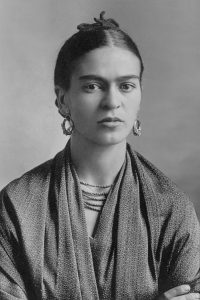
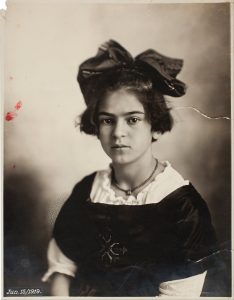
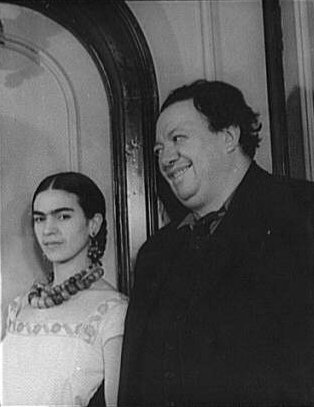









 Member since 2019 | JM14274
Member since 2019 | JM14274


NO COMMENT